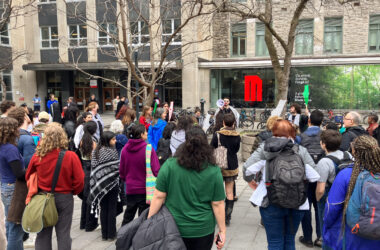Greenpeace protesters greeted delegates at the World Energy Congress 2010, a triennial energy summit held at the Palais de Congrès last week, while covered in molasses in an attempt to resemble crude oil—a protest against drilling in the Canadian tar sands.
“The Charest government must announce an immediate moratorium on exploration for oil and gas in Quebec,” said Virginie Lambert-Ferry, climate and energy campaigner for Greenpeace, in a press release.
Activists said they were concerned about the drilling process, which increases carbon dioxide emissions and creates excess sulfur deposits, damaging the environment.
The tar sands, however, are viable sources of oil, particularly for the United States. According to Rod Sobchishin, the director of business development at Willbros, a Calgary company that builds oil pipelines, the tar sands are the largest source of oil exported to the U.S. Oil is currently being extracted from three tar sands in Alberta, which account for over 40 per cent of the domestically produced oil in Canada, according to the WEC 2010 Survey of Energy Resources Executive Summary.
After their initial protests, Greenpeace took action through bureaucratic channels on Wednesday. Julien Vincent, also a climate and energy campaigner for Greenpeace, spoke at a WEC issue session on “public awareness and involvement in decision making.”
He greeted the crowd of energy executives saying, “We are here to remove your social and political rights to operate as dirty energy companies.”
Vincent then explained Greenpeace’s “Energy Revolution” scenarios, which suggest that carbon emissions can be reduced up to 84 per cent by 2050 using renewable energy. The German space agency developed the software that Vincent uses to create models which are then verified by the European Renewable Energy Council and local experts.
Helene Pelosse, interim director-general of the International Renewable Energy Agency, spoke later on Wednesday saying that 50 per cent of the world’s energy could be renewable energy by 2050. This is contradictory to Vincent’s 100 per cent renewable energy scenario.
During Q&A for the public awareness session, a member of the audience asked Vincent about his views on nuclear power, a much-discussed topic at WEC. Vincent replied that he does not support nuclear energy because of its associated dangers. Pierre Guimond, president and CEO of the Canadian Electric Association, who chaired the session, then mentioned that Patrick Moore, one of the founders of Greenpeace, was in support of nuclear energy.
Many other speakers promoted nuclear energy at this year’s WEC, discussing the need to educate the public on the benefits and safety of nuclear power.
“Energy security is in the forefront again,” said Anne Lauvergeon, CEO of AREVA. “Once we build the [nuclear] plant, we know how much it will cost for the next sixty years.”
Petr Shchedrovitskiy, deputy director general of Russia’s State Atomic Energy Corporation Rosatom, discussed recent advancements in nuclear technology. Nuclear “fast reactors” are theoretically capable of using spent fuel from thermal reactors and carbon-free generation.
The final WEC press release stated: “included representatives from various sectors of the energy industry and Greenpeace have confirmed that it is impossible to expect successful implementation of projects if citizens are not involved in the consultation process.”
However, Vincent expressed disappointment in the integration of executives and delegates.
“The level of involvement in civil society in this congress has not been what it should be,” he said.








